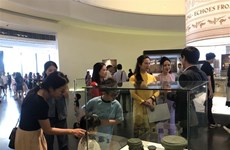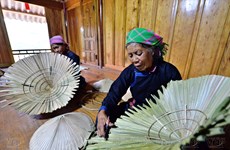Centuries-old market keeps to tradition in Hanoi
Park Chung-bae and his wife, who've rented a two-storey house in Hanoi's My Dinh Ward, said they visited the centuries-old Buoi Market in
the capital to buy ornamental plants for their home.
Park Chung-bae and his wife, who've rented a two-storey house in Hanoi's My Dinh Ward, said they visited the centuries-old Buoi Market in
the capital to buy ornamental plants for their home.
"It's really a genuine old festival of bonsai, ornamental plants and different kinds of pets such as birds, cats, dogs and fishes inside such a modern city like Hanoi," said Park, adding that his wife had bought dozens of flowers, trees and pots.
Many foreigners visit the market to buy things, including those on tours, Park said.
Like the couple from the Republic of Korea , young local couple, Anh Tuan and his wife, came to the market to buy several areca trees to plant in front of their house.
"Areca trees are also abundant at the market so we can choose the best ones, at an affordable price," said Tuan.
Buoi Market is open six days every lunar month on the 4th, 9th, 14th, 19th, 24th and 29th.
No one knows exactly when Buoi Market was established, but several documents report that it was formed during the Ly dynasty (1010-1225), though others say that the market was developed in the early 19th century.
Buoi Market is located in Yen Thai Village of Tay Ho District in Hanoi . In the past it was located in the suburbs of Thang Long (now Hanoi ) in the middle of To Lich and Thien Phu rivers, a favourable position for bustling trading areas in the west of the capital.
Buoi Ward resident Nguyen Van Thanh, 95, said that in the past the market focused on selling seeds, seedlings, breeding animals, farm tools and specialities of traditional villages.
"Buoi Market is one of a few markets in Hanoi retaining its tradition of special market days on the auspicious 4th and 9th days of each lunar month," said Thanh, adding that the market was once a good and convenient place for local people to exchange their goods and farm produce.
The market was officially built in the late 19th century with wood. In the 1930s, the French rebuilt it with concrete.
As described in ancient documents, Buoi Market consisted of 25 stalls selling different kinds of paper made by villagers in the Ke Buoi area, including tissue paper from Yen Thai Village , inferior tissue paper from Ho Khau Village, and litmus paper from Dong Xa village.
Also, many kinds of farming tools, such as ploughs, hoes and spades were also sold at the market to serve farmers in neighbouring areas. Other products, such as An Phu malt, Xuan Dinh confectionery and Vong green rice flakes, were available at the market.
Store owners from the inner city often went to the market to buy products to resell in their shops. Candy made in Lu Village was always a popular item. Children of all ages can enjoy tasty keo bot (flour candy), keo vung (sesame candy), keo lac (peanut candy), popcorn and rice crisps sold by an elderly lady with black teeth and wearing a triangular kerchief on her head.
Other goods can also be found at the market, such as shrimp and fish from the Red River and West Lake , vegetables from many villages near the To Lich and Nhue rivers and specialities from other parts of the country as well.
Probably the most sought after items on sale at the market are various kinds of fruit trees, flowers and ornamental plants from famous villages around West Lake , like Yen Phu, Nghi Tam, Quang Ba, Nhat Tan, Tay Tuu and Phu Thuong.
"On market days, it was so bustling that I can still remember a horse neighing and a pig squealing. What a pity, such images now can only be found in rural and mountainous areas like Sa Pa in the northwestern region," Thanh said.
The market was re-built in the 1990s at a very spacious place, but it's not the only market for farm produce and farming tools as it once was in the past. It now serves modern people with pets and ornamental trees.
The only seller still alive, elder Le Thi Tho, 80, who has sold vegetable seeds such as squash, pumpkin and chayote in the market for more than 60 years, says she misses the old market days very much although "buyers still come to buy my seeds, which are very high quality."
"If I retire, I will miss them very much because we often exchange information about the seeds and their crops and recall the old days of the market," says Tho.
She also says, however, that it's not only old and middle-age people that remember Buoi Market's older days. Youngsters can enjoy the market as well.
The market remains an interesting place for all Hanoians, says Tho./.
"It's really a genuine old festival of bonsai, ornamental plants and different kinds of pets such as birds, cats, dogs and fishes inside such a modern city like Hanoi," said Park, adding that his wife had bought dozens of flowers, trees and pots.
Many foreigners visit the market to buy things, including those on tours, Park said.
Like the couple from the Republic of Korea , young local couple, Anh Tuan and his wife, came to the market to buy several areca trees to plant in front of their house.
"Areca trees are also abundant at the market so we can choose the best ones, at an affordable price," said Tuan.
Buoi Market is open six days every lunar month on the 4th, 9th, 14th, 19th, 24th and 29th.
No one knows exactly when Buoi Market was established, but several documents report that it was formed during the Ly dynasty (1010-1225), though others say that the market was developed in the early 19th century.
Buoi Market is located in Yen Thai Village of Tay Ho District in Hanoi . In the past it was located in the suburbs of Thang Long (now Hanoi ) in the middle of To Lich and Thien Phu rivers, a favourable position for bustling trading areas in the west of the capital.
Buoi Ward resident Nguyen Van Thanh, 95, said that in the past the market focused on selling seeds, seedlings, breeding animals, farm tools and specialities of traditional villages.
"Buoi Market is one of a few markets in Hanoi retaining its tradition of special market days on the auspicious 4th and 9th days of each lunar month," said Thanh, adding that the market was once a good and convenient place for local people to exchange their goods and farm produce.
The market was officially built in the late 19th century with wood. In the 1930s, the French rebuilt it with concrete.
As described in ancient documents, Buoi Market consisted of 25 stalls selling different kinds of paper made by villagers in the Ke Buoi area, including tissue paper from Yen Thai Village , inferior tissue paper from Ho Khau Village, and litmus paper from Dong Xa village.
Also, many kinds of farming tools, such as ploughs, hoes and spades were also sold at the market to serve farmers in neighbouring areas. Other products, such as An Phu malt, Xuan Dinh confectionery and Vong green rice flakes, were available at the market.
Store owners from the inner city often went to the market to buy products to resell in their shops. Candy made in Lu Village was always a popular item. Children of all ages can enjoy tasty keo bot (flour candy), keo vung (sesame candy), keo lac (peanut candy), popcorn and rice crisps sold by an elderly lady with black teeth and wearing a triangular kerchief on her head.
Other goods can also be found at the market, such as shrimp and fish from the Red River and West Lake , vegetables from many villages near the To Lich and Nhue rivers and specialities from other parts of the country as well.
Probably the most sought after items on sale at the market are various kinds of fruit trees, flowers and ornamental plants from famous villages around West Lake , like Yen Phu, Nghi Tam, Quang Ba, Nhat Tan, Tay Tuu and Phu Thuong.
"On market days, it was so bustling that I can still remember a horse neighing and a pig squealing. What a pity, such images now can only be found in rural and mountainous areas like Sa Pa in the northwestern region," Thanh said.
The market was re-built in the 1990s at a very spacious place, but it's not the only market for farm produce and farming tools as it once was in the past. It now serves modern people with pets and ornamental trees.
The only seller still alive, elder Le Thi Tho, 80, who has sold vegetable seeds such as squash, pumpkin and chayote in the market for more than 60 years, says she misses the old market days very much although "buyers still come to buy my seeds, which are very high quality."
"If I retire, I will miss them very much because we often exchange information about the seeds and their crops and recall the old days of the market," says Tho.
She also says, however, that it's not only old and middle-age people that remember Buoi Market's older days. Youngsters can enjoy the market as well.
The market remains an interesting place for all Hanoians, says Tho./.













